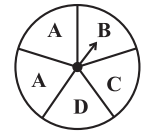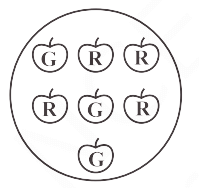NCERT Solutions Class 8 Mathematics
Chapter – 5 (Data Handling)
The NCERT Solutions in English Language for Class 8 Mathematics Chapter – 5 Data Handling Exercise 5.3 has been provided here to help the students in solving the questions from this exercise.
Chapter 5: Data Handling
Exercise – 5.3
1. List the outcomes you can see in these experiments.
(a) Spinning a wheel
(b) Tossing two coins together

Solution –
(a) There are four letters A, B, C and D in a spinning wheel. So, there are 4 outcomes.
(b) When two coins are tossed together. There are four possible outcomes HH, HT, TH, and TT. (where, Head – H and Tail – T). Hence, there are 4 outcomes.
2. When a die is thrown, list the outcomes of an event of getting
(i) (a) a prime number (b) not a prime number
(ii) (a) a number greater than 5 (b) a number not greater than 5
Solution – When a die is thrown, there are six possible outcomes 1, 2, 3, 4, 5 and 6
(i) (a) Outcomes of the event of getting a prime number are 2, 3 and 5.
(b) Outcomes of the event of not getting a prime number are 1, 4 and 6.
(ii) (a) Outcomes of the event of getting a number greater than 5 is 6.
(b) Outcomes of the event of not getting a number greater than 5 are 1, 2, 3, 4 and 5.
3. Find the.
(a) Probability of the pointer stopping on D in (Question 1-(a)).
(b) Probability of getting an ace from a well-shuffled deck of 52 playing cards.
(c) Probability of getting a red apple. (See figure below)


Solution –
(a) In a spinning wheel, there are five pointers A, A, B, C, D. So, there are five outcomes. The pointer stops at D, which is one outcome.
So, the probability of the pointer stopping on D =
(b) There are 4 aces in a deck of 52 playing cards. So, there are four events for getting an ace.
So, the probability of getting an ace =
(c) Total number of apples = 7
Number of red apples = 4
Probability of getting a red apple =
4. Numbers 1 to 10 are written on ten separate slips (one number on one slip), kept in a box and mixed well. One slip is chosen from the box without looking into it. What is the probability of
(i) getting a number 6?
(ii) getting a number less than 6?
(iii) getting a number greater than 6?
(iv) getting a 1-digit number?
Solution –
(i) Outcome of getting a number 6 from ten separate slips is one.
∴ probability of getting a number 6 =
(ii) Numbers less than 6 are 1, 2, 3, 4 and 5, which are five. So, there are 5 outcomes.
∴ probability of getting a number less 6 =
(iii) Number greater than 6 out of ten that are 7, 8, 9, 10. So there are 4 possible outcomes.
∴ probability of getting a number greater than 6 =
(iv) One-digit numbers are 1, 2, 3, 4, 5, 6, 7, 8, 9 out of ten.
∴ probability of getting a 1-digit number =
5. If you have a spinning wheel with 3 green sectors, 1 blue sector and 1 red sector, what is the probability of getting a green sector? What is the probability of getting a non-blue sector?
Solution – Given that there is a spinning wheel with 3 green sectors, 1 blue sector and 1 red sector
Total number of sectors = 5
Total number of green sectors = 3
Therefore, probability of getting a green sector =
Total number of blue sectors = 1
Total number of non-blue sectors = 5 – 1 = 4
Therefore, the probability of getting a non-blue sector =
6. Find the probabilities of the events given in Question 2.
Solution – When a die is thrown, there is a total of six outcomes, i.e., 1, 2, 3, 4, 5 and 6.
(i) (a) 2, 3, 5 are the prime numbers. So, there are 3 outcomes out of 6.
∴ probability of getting a prime number = =
(b) 1, 4, 6 are not the prime numbers. So, there are 3 outcomes out of 6.
∴ probability of getting a prime number = =
(ii) (a) Only 6 is greater than 5.
So there is one outcome out of 6.
∴ probability of getting a number greater than 5 =
(b) Numbers not greater than 5 are 1, 2, 3, 4 and 5. So there are 5 outcomes out of 6.
∴ probability of not getting a number greater than 5 =

Leave a Reply